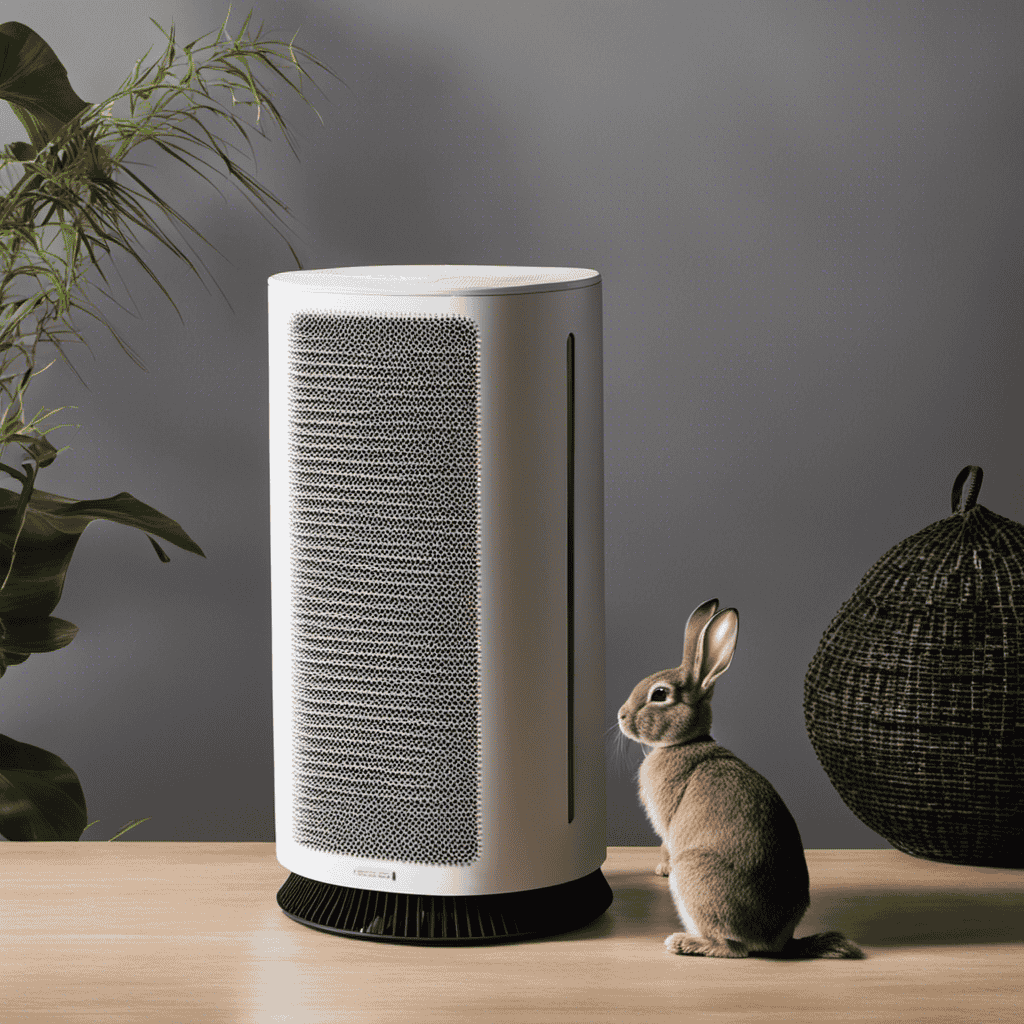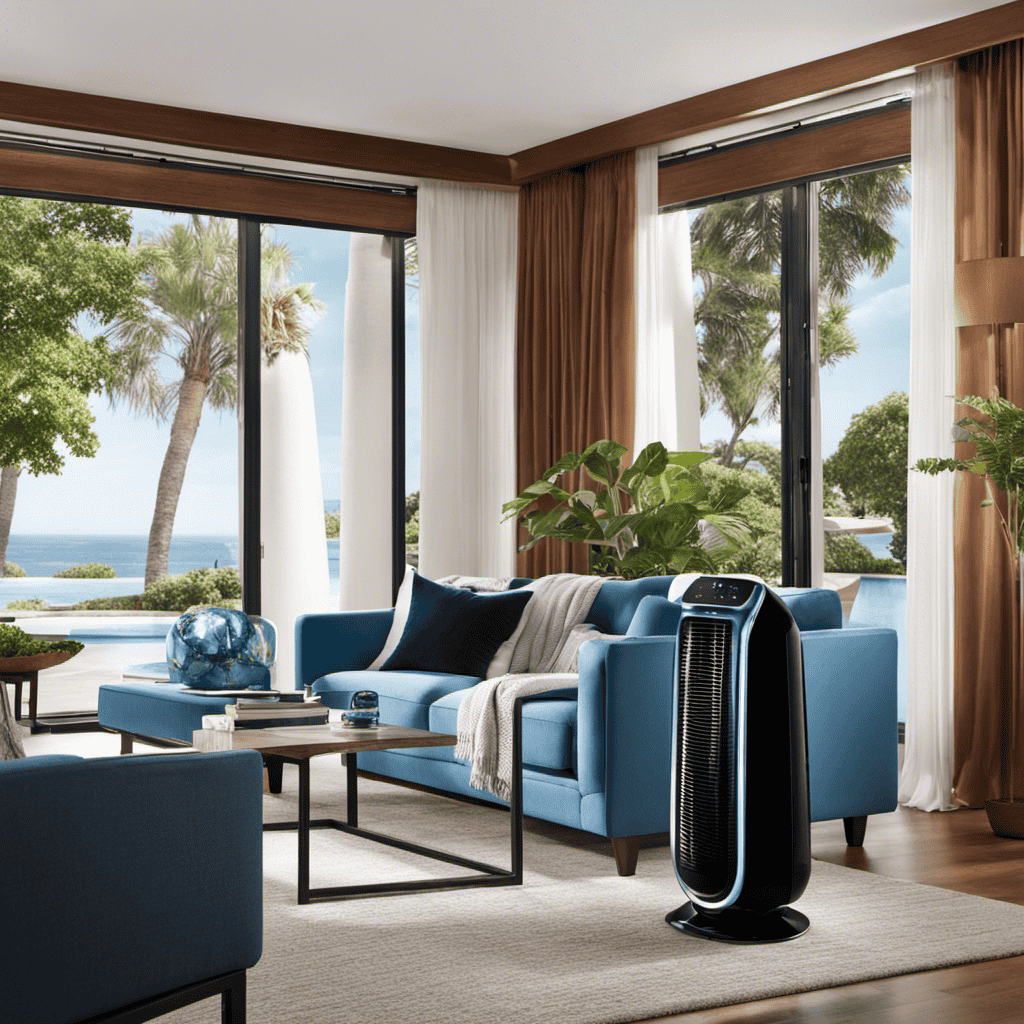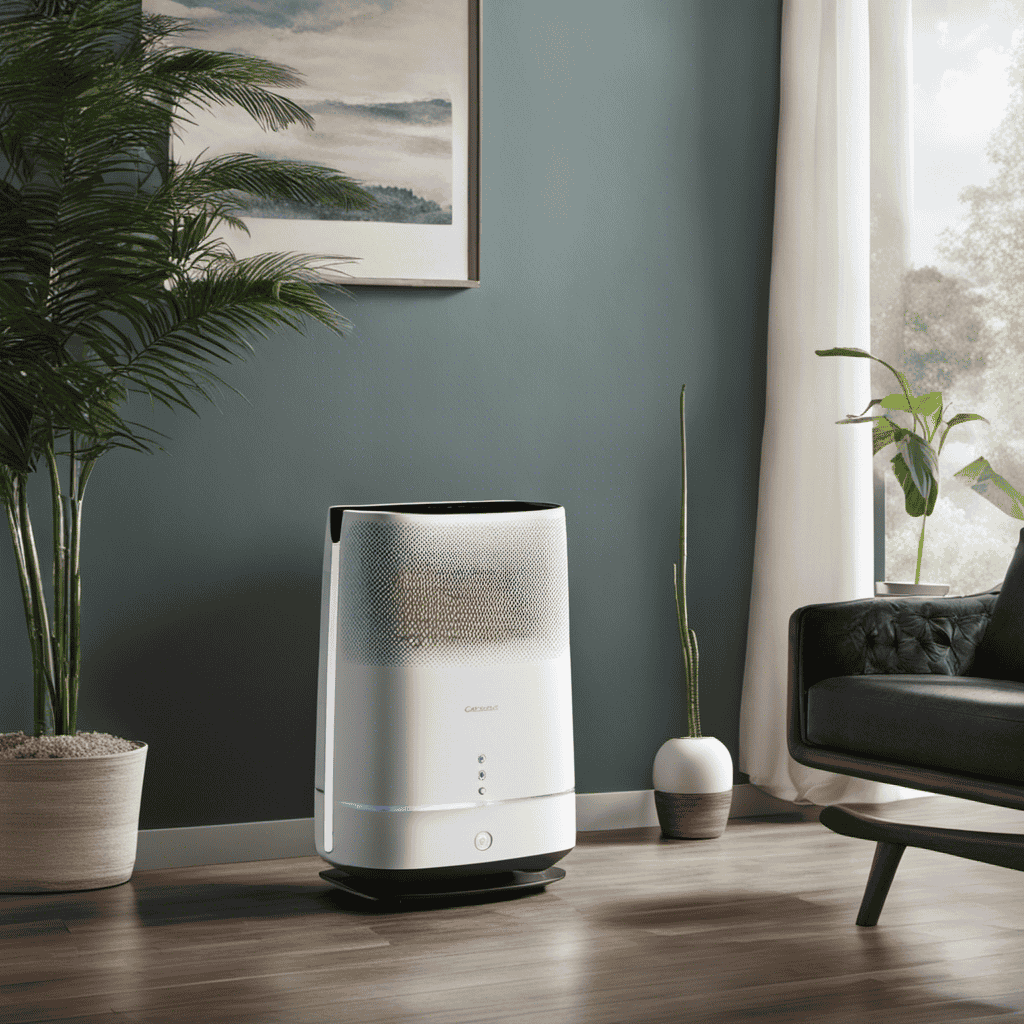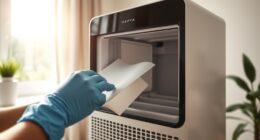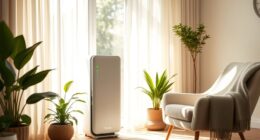Lying in bed, inhaling the musty air of my bedroom, I found myself pondering: what size air purifier should I get?
Determining the right air purifier size for your bedroom is crucial for optimal air quality.
In this article, we will delve into the factors to consider when choosing the perfect size, such as the square footage of your room and the importance of air exchange rate.
Don’t make the mistake of overlooking this vital step in creating a clean and healthy sleep environment.
Key Takeaways
- Air purifier size is determined by coverage area
- Smaller air purifiers are suitable for bedrooms or small offices
- Factors to consider when choosing an air purifier size include room size, CADR rating, filtration type, and budget
- Calculating the square footage of your bedroom is important in determining the appropriate air purifier size
Understanding Air Purifier Sizes
To understand air purifier sizes, you’ll need to know how they are measured and what each size is recommended for.
When it comes to air purifiers, size matters. The size of an air purifier is determined by its coverage area, which is the maximum square footage it can effectively clean. Factors affecting air purifier performance include room size, air quality, and the level of pollutants present.
A smaller air purifier is suitable for a bedroom or small office, while a larger one is needed for open-plan spaces. It’s important to choose the right size to ensure optimal purification.
One key factor to consider is the benefits of HEPA filtration. HEPA filters are highly efficient at removing airborne particles, allergens, and pollutants, providing cleaner and healthier air for you to breathe.
Factors to Consider When Choosing an Air Purifier Size
When choosing an air purifier, you’ll want to consider factors such as the square footage of your room and the CADR rating. Determining your budget and understanding filtration technology are also crucial. To help you make an informed decision, here is a table summarizing the factors to consider when choosing an air purifier size:
| Factor | Importance | Explanation |
|---|---|---|
| Room Size | High | The square footage of your room helps determine the appropriate size of the air purifier. |
| CADR Rating | High | The Clean Air Delivery Rate (CADR) measures an air purifier’s efficiency in removing pollutants. |
| Filtration Type | Medium | Different air purifiers use various filtration technologies, such as HEPA or activated carbon filters. |
Considering these factors will ensure that you choose the right size air purifier for your room, within your budget, and with the appropriate filtration technology to meet your specific needs.
Determining the Square Footage of Your Bedroom
Determining the square footage of your bedroom can help you select the right air purifier. To calculate the dimensions of your room, you can follow these steps:
- Measure the length and width of your bedroom using a tape measure.
- Multiply the length and width together to get the total square footage.
- If your room has any odd angles or alcoves, measure those separately and add them to the total.
- If you prefer a more convenient method, you can also use online room size calculators that will do the math for you.
Calculating the square footage of your bedroom is essential because it ensures that you choose an air purifier that can effectively clean the air in your space.
Once you have determined the size of your room, you can move on to considering the importance of air exchange rate in selecting the right air purifier.
The Importance of Air Exchange Rate
Once you’ve determined the square footage of your bedroom, it’s important to understand the significance of the air exchange rate when selecting an appropriate air purifier.
The air exchange rate refers to the number of times the air in a room is replaced with fresh air within an hour. This is a crucial factor to consider because it determines how effectively the air purifier can filter and clean the air in your bedroom.
Understanding air filtration and the benefits of clean air is essential for choosing the right air purifier.
Air purifiers with higher air exchange rates are better at removing pollutants, allergens, and other harmful particles from the air. This means that they can provide cleaner and healthier air for you to breathe, reducing the risk of respiratory problems and allergies.
By selecting an air purifier with an appropriate air exchange rate, you can ensure that your bedroom remains a clean and healthy environment.
Recommended Air Purifier Size for Small Bedrooms
To ensure optimal air quality in smaller bedrooms, it’s important to choose an air purifier that is recommended for compact spaces. Here are four recommended air purifier brands that are perfect for small bedrooms:
-
Honeywell: Known for their high-quality air purifiers, Honeywell offers compact models that are perfect for small bedrooms. Their True HEPA filters capture up to 99.97% of airborne particles, ensuring clean and fresh air.
-
Coway: Coway air purifiers are not only sleek and stylish, but they also provide excellent air purification. Their models are designed to effectively remove allergens, pet dander, and odors from the air, making them ideal for small bedrooms.
-
Levoit: Levoit air purifiers are compact yet powerful. They feature advanced filtration systems that eliminate dust, pollen, and other pollutants from the air. With their quiet operation, they won’t disturb your sleep.
-
GermGuardian: GermGuardian air purifiers are perfect for small bedrooms due to their compact size and powerful performance. They use UV-C light technology to kill germs and bacteria, ensuring a healthier living environment.
In addition to these recommended brands, there are several benefits of using air purifiers in small bedrooms. They help remove allergens, dust, and pet dander, improving indoor air quality and reducing allergy symptoms. Air purifiers also help eliminate unpleasant odors, making your bedroom a more pleasant and inviting space. Finally, they can provide relief for those suffering from respiratory conditions such as asthma or COPD, by removing airborne irritants that can trigger symptoms.
Overall, investing in a recommended air purifier for your small bedroom can greatly improve the air quality and your overall well-being.
Recommended Air Purifier Size for Medium Bedrooms
When choosing an air purifier for your medium-sized bedroom, make sure it is powerful enough to effectively clean the air and improve your indoor air quality.
The effectiveness of an air purifier depends on its CADR (Clean Air Delivery Rate) rating, which measures how quickly it can filter out pollutants such as dust, pollen, and smoke.
For a medium-sized bedroom, a CADR rating of at least 200 is recommended to ensure efficient air purification.
Additionally, regular maintenance of your air purifier is crucial for optimal performance. This includes replacing the filters as recommended by the manufacturer, typically every 6-12 months, and cleaning the unit regularly to prevent the buildup of dust and debris.
Recommended Air Purifier Size for Large Bedrooms
When it comes to large bedrooms, the recommended size of an air purifier is slightly different. Here are some key factors to consider:
-
Coverage area: For a large bedroom, you’ll need an air purifier that can effectively clean the entire space. Look for models that cover at least 300-400 square feet.
-
Ideal air purifier placement: It’s important to strategically place the air purifier in your bedroom. Consider placing it near the bed or in a corner where it can draw in the maximum amount of air.
-
Noise level considerations: Since the air purifier will be in your bedroom, it’s crucial to choose a model with a noise level that won’t disturb your sleep. Look for purifiers that operate quietly, ideally below 50 decibels.
-
Additional features: Some air purifiers come with additional features like night modes, sleep timers, and remote controls. These can enhance your overall experience and convenience.
Now that we’ve discussed the recommended size for large bedrooms, let’s move on to choosing the right CADR (Clean Air Delivery Rate) for your bedroom.
Choosing the Right CADR (Clean Air Delivery Rate) for Your Bedroom
When it comes to choosing the right CADR (Clean Air Delivery Rate) for your bedroom, it’s important to consider the size of the room. A higher CADR is typically recommended for larger rooms, as it indicates a higher level of air cleaning capability.
However, it’s also crucial to balance efficiency and effectiveness, as a higher CADR may consume more energy.
CADR and Room Size
To determine the right size air purifier for your bedroom, measure the room’s square footage and then check the Clean Air Delivery Rate (CADR) recommendations for that room size. Considering the CADR and room size is crucial when it comes to improving indoor air quality and addressing specific health concerns like allergies and asthma.
Here’s why:
-
CADR and Allergies: A higher CADR ensures that the air purifier can effectively remove allergens like pollen, dust mites, and pet dander, providing relief for allergy sufferers.
-
Room Size and Asthma: For individuals with asthma, it is important to choose an air purifier that matches the room’s size. This ensures efficient air circulation, reducing the presence of asthma triggers such as dust particles and mold spores.
-
Optimal Performance: Selecting an air purifier with the right CADR for your room size ensures that it can effectively clean the air, providing maximum benefits for your health.
-
Energy Efficiency: By choosing an air purifier that is sized appropriately for your room, you can avoid wasting energy and save on electricity bills.
Considering the CADR and room size is essential for choosing the right air purifier that can effectively address your specific health concerns and improve the quality of air in your bedroom.
Efficiency Vs. Effectiveness
If you want to improve indoor air quality and address allergies or asthma, it’s important to consider the efficiency and effectiveness of an air purifier.
When it comes to efficiency versus cost, it’s crucial to strike a balance. A highly efficient air purifier may have a higher upfront cost, but it can save you money in the long run by reducing energy consumption and filter replacement frequency. On the other hand, a cheaper option may be less efficient and end up costing you more in the long term.
As for effectiveness versus noise level, it’s essential to find a purifier that effectively removes pollutants while maintaining a tolerable noise level. Some air purifiers are designed to operate quietly, making them ideal for bedrooms or other quiet spaces.
Additional Features to Consider in an Air Purifier for Your Bedroom
When it comes to choosing an air purifier for my bedroom, two key points that I consider are the noise level and the benefits of smart technology.
Noise level is important to me because I want a purifier that operates quietly, allowing me to sleep soundly without any disturbances.
Additionally, the benefits of smart technology are a key consideration as it allows for convenient control and monitoring of the purifier, ensuring optimal air quality in my bedroom.
Noise Level Importance
Consider how important noise level is to you when choosing the size of an air purifier for your bedroom. The noise level of an air purifier can have a significant impact on your sleep quality. Here are some noise level considerations to keep in mind:
-
Decibel ratings: Look for air purifiers with low decibel ratings, ideally below 50 dB. This ensures a quiet operation that won’t disturb your sleep.
-
Fan speed settings: Opt for a purifier with adjustable fan speed settings. This allows you to customize the noise level based on your preferences and the surrounding environment.
-
Sleep mode: Many air purifiers come with a sleep mode feature, which reduces noise levels and dims the lights for a more peaceful sleep environment.
-
White noise benefits: Some individuals find a low level of white noise generated by an air purifier to be soothing and helpful for falling asleep.
Considering the noise level of an air purifier is crucial for ensuring a restful night’s sleep. Now, let’s explore the benefits of smart technology in air purifiers.
Smart Technology Benefits
Smart technology in air purifiers offers numerous benefits. These include remote control operation and automatic air quality monitoring. These advancements have revolutionized the way we interact with and benefit from air purifiers.
With remote control operation, I can easily adjust the settings of my air purifier from anywhere in the room. This provides convenience and ease of use. Additionally, the automatic air quality monitoring feature allows the purifier to detect and respond to changes in air quality. This ensures that I always have clean and fresh air.
Furthermore, these advancements have led to significant energy consumption reduction in air purifiers. This makes them more environmentally friendly and cost-effective.
As we move forward, it is important to consider these smart technology benefits when selecting the size of an air purifier. This will help us avoid common mistakes.
Common Mistakes to Avoid When Selecting the Size of an Air Purifier
Make sure you don’t overlook common mistakes to avoid when choosing the size of your air purifier for the bedroom. The size of an air purifier plays a crucial role in its performance and effectiveness. Here are four factors to consider:
-
Room size: The first step is to determine the square footage of your bedroom. This will help you choose an air purifier with the appropriate coverage area.
-
Clean air delivery rate (CADR): Look for an air purifier with a CADR rating that matches the size of your room. This rating indicates how quickly the purifier can clean the air.
-
Filter replacement: Regularly replacing the filters is essential for optimal performance. Neglecting this can lead to reduced efficiency and poor air quality.
-
Noise level: Consider the noise level of the air purifier. For the bedroom, you want a purifier that operates quietly, ensuring a peaceful sleep environment.
Tips for Proper Placement of Your Bedroom Air Purifier
When it comes to ensuring the effectiveness of an air purifier, proper placement is crucial. In this discussion, we will explore the ideal purifier placement and common mistakes to avoid.
Ideal Purifier Placement
You’ll want to consider the ideal placement for the purifier in your bedroom. Here are some key factors to keep in mind:
-
Distance from your bed: Place the purifier within a few feet of your bed to ensure maximum efficiency in improving sleep quality. This will ensure that the purified air is easily reaching you while you sleep.
-
Positioning: It’s recommended to place the purifier in a central location in the room. This allows for better air circulation and distribution throughout the entire space, ensuring that all corners of your bedroom receive clean air.
-
Avoid obstructions: Make sure to keep the purifier away from any obstructions such as curtains, furniture, or walls. This will prevent any hindrance in the air flow and allow the purifier to work optimally.
-
Consider noise levels: While air purifiers are generally quiet, it’s still important to consider placing the unit at a reasonable distance from your bed to minimize any potential noise disturbances during sleep.
Common Placement Mistakes?
To ensure optimal performance, it’s important to avoid placing the purifier near curtains, furniture, or walls. Many people have the misconception that placing the air purifier near these objects will help in better air circulation. However, this can actually hinder the purifier’s ability to effectively clean the air.
Curtains and furniture can block the airflow and prevent the purifier from reaching its full potential. Walls can also obstruct the air purifier’s ability to capture pollutants. It is recommended to place the purifier in the center of the room, away from any obstructions.
This allows for better air circulation and ensures that the purifier can effectively clean the air in the entire space. By following these placement tips and avoiding common misconceptions, you can maximize the performance of your air purifier and improve the air quality in your home.
Frequently Asked Questions
Can I Use a Larger Air Purifier in a Small Bedroom?
Yes, using a larger air purifier in a small bedroom can have benefits. It can provide more efficient air purification, cover a larger area, and remove more pollutants, ensuring cleaner and healthier air.
How Often Should I Change the Air Filters in My Air Purifier?
I change the air filters in my air purifier every three months. It’s important to keep them clean and functioning properly to ensure the best air quality in my bedroom.
Can an Air Purifier Remove Cigarette Smoke and Pet Odors From My Bedroom?
An air purifier can effectively remove cigarette smoke and pet odors from your bedroom. It offers numerous benefits, such as improved air quality and reduced allergens, making it a worthwhile investment for a cleaner and healthier sleeping environment.
Is It Necessary to Run the Air Purifier 24/7 in My Bedroom?
It’s important to run the air purifier 24/7 in my bedroom to maintain good air quality. I once turned it off for a few hours and noticed a difference in how stuffy and dusty the room became.
Are There Any Health Risks Associated With Using an Air Purifier in the Bedroom?
Using an air purifier in the bedroom has health benefits, such as reducing allergens and improving air quality. However, potential side effects like dryness or irritation can occur, so it’s important to choose the right size and follow manufacturer recommendations.
Conclusion
After thorough research and analysis, I’ve concluded that selecting the right size air purifier for your bedroom is crucial for clean and healthy air. Factors like bedroom square footage and air exchange rate determine the appropriate size. It’s also important to consider the CADR and additional features. By avoiding common mistakes and placing the air purifier properly, you can create a serene environment and enjoy the benefits of clean air in your bedroom.

